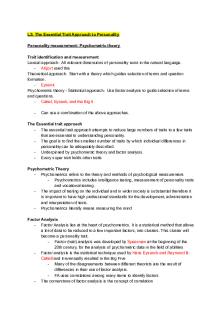Psychodynamic approach and compare it to the humanistic approach PDF

| Title | Psychodynamic approach and compare it to the humanistic approach |
|---|---|
| Course | Social Psychology |
| Institution | The University of Warwick |
| Pages | 1 |
| File Size | 34.6 KB |
| File Type | |
| Total Downloads | 90 |
| Total Views | 159 |
Summary
Download Psychodynamic approach and compare it to the humanistic approach PDF
Description
Outline the psychodynamic approach and compare it to the humanistic approach. The psychodynamic approach argues that most of our mind is made up of the unconscious; a vast store of biological drives and instincts that influence our behaviour and personality. It also contains threatening and disturbing memories that have been repressed or locked away. These can be accessed through ‘slips of the tongue’ (parapraxes) such as calling your teacher ‘mum’ instead of ‘miss’. Preconscious mind contains thoughts not currently in conscious awareness but can still be accessed. Freud claimed that child development occurred in five stages such as the oral and phallic stage; any that psychosexual stage that is unresolved leads to fixation where the child becomes ‘stuck’ carrying conflicts associated with that stage onto adulthood. Defence mechanisms are also unconscious mechanisms that ensure that the ego is able to prevent us from being overwhelmed by threats & trauma; repression, denial and displacement. The psychodynamic approach also looks at the ‘tripartite’ structure of personality identified by Freud; the id (operating on the pleasure principle), the ego (operating on the reality principle) and the superego, based on the morality principle. One difference between the psychodynamic and humanistic approach is the extent to which each approach claims that behaviour is determined. The psychodynamic approach claims that behaviour is determined by unconscious drives and early childhood experiences – psychic determinism. The humanistic approach, however, emphasises the role of free will, claiming that human beings are essentially self-determining as we are active agents with the ability to determine our own development. Therefore, while the psychodynamic approach offers a more deterministic approach to the explanation of behaviour, the humanistic approach acknowledges the role of free will. This is more of a strength than the psychodynamic approach as it assumes that people can reach self-actualisation by making individual changes in their own lives. A similarity, however, is that both have had significant real-world applications. The psychodynamic theory has enabled psychologists to clinically address what occurs in the conscious mind and its impact on behaviour; psychodynamic theory in the form of psychoanalysis has been a central feature in the history of psychiatry as a medical speciality. This therapy can include hypnosis, dream analysis and other techniques aimed at accessing the unconscious. Similarly, the humanistic approach has led to the development of Rogers’ client-centred therapy, praised as an effective approach that focuses on present problems and works to reduce the level of incongruence between the self-concept and ideal-self. Thus, both the psychodynamic and humanistic approach have been an influential element in the development of later therapies such as client-centred therapy and psychoanalysis, and therefore both approaches have provided positive applications to the treatments of numerous disorders over the years.
Both use case-studies; criticise this or discuss the strength. Both unscientific Psychodynamic focuses on unconscious while humanistic focuses on conscious; difference. Both test on humans Both idiographic Diff; psychodynamic occurs in developmental psychosexual stages. Humanistic is ongoing in life....
Similar Free PDFs

Psychodynamic Approach
- 2 Pages

Marxist approach to IR
- 27 Pages

Approach to communication ex
- 1 Pages

Business Approach to Management
- 7 Pages

The cognitive approach
- 1 Pages

The situational approach
- 1 Pages
Popular Institutions
- Tinajero National High School - Annex
- Politeknik Caltex Riau
- Yokohama City University
- SGT University
- University of Al-Qadisiyah
- Divine Word College of Vigan
- Techniek College Rotterdam
- Universidade de Santiago
- Universiti Teknologi MARA Cawangan Johor Kampus Pasir Gudang
- Poltekkes Kemenkes Yogyakarta
- Baguio City National High School
- Colegio san marcos
- preparatoria uno
- Centro de Bachillerato Tecnológico Industrial y de Servicios No. 107
- Dalian Maritime University
- Quang Trung Secondary School
- Colegio Tecnológico en Informática
- Corporación Regional de Educación Superior
- Grupo CEDVA
- Dar Al Uloom University
- Centro de Estudios Preuniversitarios de la Universidad Nacional de Ingeniería
- 上智大学
- Aakash International School, Nuna Majara
- San Felipe Neri Catholic School
- Kang Chiao International School - New Taipei City
- Misamis Occidental National High School
- Institución Educativa Escuela Normal Juan Ladrilleros
- Kolehiyo ng Pantukan
- Batanes State College
- Instituto Continental
- Sekolah Menengah Kejuruan Kesehatan Kaltara (Tarakan)
- Colegio de La Inmaculada Concepcion - Cebu









